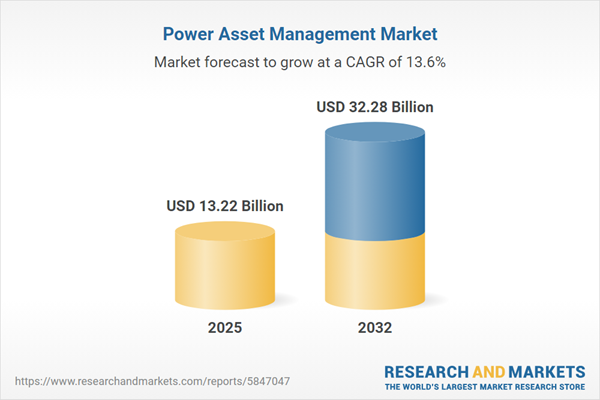Speak directly to the analyst to clarify any post sales queries you may have.
The power asset management market is evolving as executive teams adapt to complex portfolios, heightened regulatory scrutiny, and digitalization throughout the energy sector. Senior decision-makers are now emphasizing operational resilience, data integration, and strategic adaptability to secure a long-term leadership position in an increasingly dynamic environment.
Market Snapshot: Power Asset Management Market Growth Trajectory
The power asset management market is forecast to enter a strong growth phase, with valuation rising from USD 11.66 billion in 2024 to USD 13.22 billion in 2025, progressing further to USD 32.28 billion by 2032. This growth is driven by increased investments in digital initiatives, evolving regulatory landscapes, and greater urgency in modernizing infrastructure. Senior leaders are responding by prioritizing adaptive asset management strategies, agile decision frameworks, and real-time data utilization. Such approaches are enabling improved portfolio oversight and procurement flexibility, equipping organizations to mitigate operational and compliance risks as sector demands accelerate.
Scope & Segmentation: Comprehensive Ecosystem Coverage
- Service Types: Consulting, operational, and maintenance services deliver enhanced asset performance, robust life-cycle management, and agility to shifting energy demand profiles.
- Asset Types: Coverage spans conventional and innovative assets, such as gas turbines, reciprocating engines, solar photovoltaics, wind energy systems, and steam turbines, supporting diverse operational strategies and resilience.
- Software Solutions: Analytics platforms, condition monitoring tools, and predictive maintenance solutions provide visibility into asset health, optimize performance, and strengthen risk management capabilities.
- End Users: Commercial, industrial, utility, and residential sectors each employ tailored asset management to support seamless integration, regulatory compliance, and operational differentiators.
- Deployment Modes: Cloud-based (public and private) and on-premise solutions enable organizations to address cybersecurity and data management aligned to unique regulatory needs.
- Regional Focus: Strategies are implemented across the Americas—including the United States, Canada, Mexico, Brazil, Argentina, Chile, Colombia, and Peru—in addition to Europe, the Middle East, Africa, and Asia-Pacific. Each region adapts to distinctive regulatory requirements and market dynamics to maximize operational performance.
- Key Companies Analyzed: The report evaluates organizations such as General Electric Company, ABB Ltd., Eaton Corporation, Siemens AG, DNV GL, Aclara Technologies, Sentient Energy, Hitachi Energy, IBM, Black & Veatch, ABS Group, Schneider Electric, Getac, IFS, Fujitsu, and Lindsey Manufacturing Company, benchmarking strategic direction and technology innovation.
Key Takeaways: Strategic Insights for Senior Leaders
- Accelerating digital transformation enables real-time oversight and rapid decision-making, an essential capability for managing change and maintaining competitive advantage.
- Advanced analytics streamline compliance and foster proactive risk management, providing a framework for organizations to navigate regulatory shifts efficiently.
- Integrated platforms improve transparency, collaboration, and workflow optimization, especially crucial across increasingly distributed asset networks.
- Adopting AI and edge computing solutions delivers greater infrastructure visibility and supports focused optimization for sustainable asset performance.
- Strengthened digital connectivity brings cybersecurity to the forefront, positioning it as a critical foundation for stable, protected asset operation.
- Ongoing partnerships between utilities, technology providers, and security firms consolidate resilience, ensuring robust risk mitigation throughout global operations.
Tariff Impact: Navigating Evolving Cost Structures
Adjustments in import tariffs, especially within the United States, are directly influencing sourcing decisions for energy organizations. To overcome volatility and comply with regulatory changes, enterprises are broadening supply chains and embracing procurement models that provide additional flexibility. The use of bundled procurement strategies is also increasing to support compliance, risk mitigation, and uninterrupted operations amid market and regulatory shifts.
Methodology & Data Sources
This research leverages quantitative market modeling, interviews with executive leaders, assessments of technology landscapes, and regulatory analysis, complemented by external expert insights. The approach provides data-driven guidance for executive teams overseeing strategic procurement and operational priorities in the power asset management sector.
Why This Report Matters for Power Asset Management
- Establishes actionable frameworks for capital planning, investment prioritization, and risk assessment to address fast-evolving market challenges.
- Links advanced digitalization and asset integration technologies to solutions that enhance compliance and drive operational efficiency.
- Equips senior executives with strategies to build robust, agile portfolios through proactive and adaptive risk management.
Conclusion
Success in power asset management will depend on cross-disciplinary collaboration and agile management. Focused innovation and disciplined execution will enable organizations to achieve consistent operational efficiency and maintain their competitive edge worldwide.
Additional Product Information:
- Purchase of this report includes 1 year online access with quarterly updates.
- This report can be updated on request. Please contact our Customer Experience team using the Ask a Question widget on our website.
Table of Contents
3. Executive Summary
4. Market Overview
7. Cumulative Impact of Artificial Intelligence 2025
Companies Mentioned
The companies profiled in this Power Asset Management market report include:- General Electric Copmpany
- ABB Ltd.
- Eaton Corporation
- Siemens AG
- DNV GL
- Aclara Technologies
- Sentient Energy
- Hitachi Energy
- International Business Machine Corporation
- Black & Veatch
- ABS Group
- Schneider Electric
- Getac
- IFS
- Fujitsu
- Lindsey Manufacturing
Table Information
| Report Attribute | Details |
|---|---|
| No. of Pages | 196 |
| Published | October 2025 |
| Forecast Period | 2025 - 2032 |
| Estimated Market Value ( USD | $ 13.22 Billion |
| Forecasted Market Value ( USD | $ 32.28 Billion |
| Compound Annual Growth Rate | 13.5% |
| Regions Covered | Global |
| No. of Companies Mentioned | 17 |









